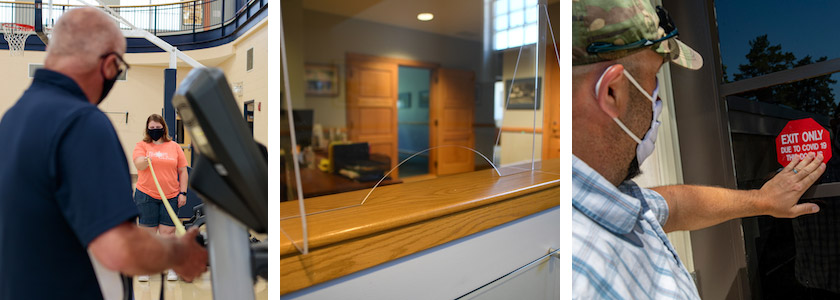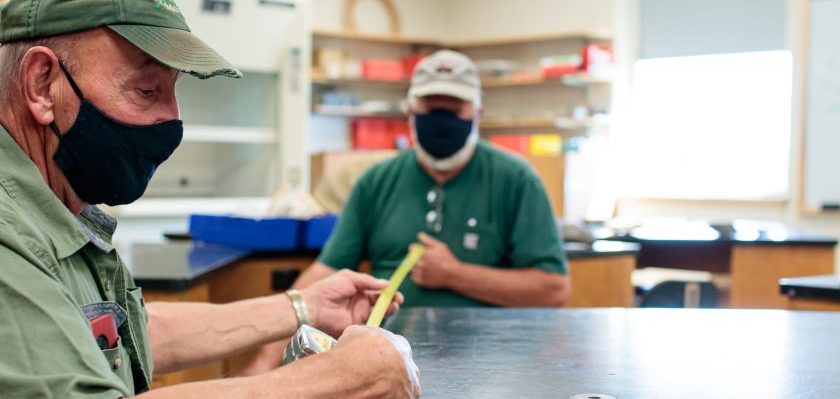1. Passing the Test and Planning for Isolation
It is important that the UMS is prepared for and committed to mitigation of viral transmission using the approach — test, trace, and isolate for safety. Each UMS campus will begin the semester with a plan and commitment for broad-based infection testing that complies with and takes safety steps stronger than those currently called for by civil authorities. Every student, faculty, and staff member from states or places beyond Maine will be required to have a negative COVID-19 test in hand when the semester begins. Further, other categories of vulnerable populations will warrant special consideration. The universities will conduct and require asymptomatic testing throughout the semester via high-quality RT-PCR testing through established partnerships. Universities will have isolation plans and spaces that permit students to continue their education during periods of mandated isolations and quarantine should such periods occur. Quarantine and isolation refer to practices for potentially ill individuals or for those known to be ill to remain away from others for a period of time. Details about testing will be forthcoming in much greater detail.
2. Staying Together for Maine

Classes will begin as scheduled on August 31. In-person instruction will end and students will be asked to depart residence halls no later than Wednesday, November 25 — the day before Thanksgiving. The final two weeks of the semester and exams will occur as scheduled after Thanksgiving, but remotely. Both travel outside of Maine during the semester and university-sponsored travel will be limited. Students or employees who do leave the state at any point during the semester will be required to adhere to the public health testing or quarantine protocols in place at the time of their return.
3. Campus space and safety modifications
Distance is a key line of defense against the spread of infection. Engineered options to improve physical distancing will include space-focused alterations to campus facilities, residence halls, and classrooms, and the installation of physical barriers in key areas of human interaction. We will work together to minimize crowds, closed spaces, and close contacts. Group-size limitations, fewer students in residence, and innovative classroom locations and approaches will further help us de-densify campus. The universities will also be focused and investing in increased cleaning protocols and new hand sanitation stations, and providing disinfectant wipes at key locations.
- Six-foot or more physical distancing:
Instructional, administrative and other spaces will be updated to accommodate physical distancing of six feet or more. This includes marking seats, rearranging or removing furniture, marking distancing spaces in areas where queues may form, and other steps as may be warranted to promote and make possible physical distancing. This includes classrooms, offices, and common residential and social spaces. - Handwashing and sanitizer stations:
Handwashing will be strongly encouraged and supported with supplies and signage. Numerous hand sanitizer stations also will be visible and available inside the entrances of facilities and throughout campus facilities. - One-way foot traffic:
Pedestrian foot traffic will be differentiated by direction in some areas. This may include steps such as designating areas of one-way foot traffic, enter-only and exit-only at classroom and building access points (except in the case of emergencies), and physical separation devices. - Paper towels in lieu of air dryers:
Paper towels and appropriate emptying of the associated trash receptacles will replace air hand dryers. - Disinfectant wipes:
Disinfectant supplies will be available at many locations for the immediate wiping down of common spaces and places such as classroom desks by individual users. - Physical barriers:
Physical barriers of various kinds are being installed to shield individuals from the respiratory droplets of others in many areas where person-to-person interactions occur. - Signage:
There will be signs posted to remind all of us of the various changes in practices and the things we all can do to help ensure in-person education can continue.
4. Making a pledge is the Maine thing
Each student, staff, and faculty member will be asked and challenged to be a champion for keeping themselves and others safe. Social compacts or pledges will be in place at all campuses. These pledges will include commitments to science-based practices, such as wearing a face covering, that are clearly demonstrated to significantly reduce the spread of disease. The pledges will also include actions such as monitoring your own health, avoiding unnecessary travel, and staying home when sick.
5. Communication will be crucial
The Chancellor and presidents will be communicating openly and often about our status, adjustments to this plan and about the System’s ability to continue with in-person instruction. Guidance will be clear and updated immediately when necessary to maintain alignment with the directives of civil authorities.

6. Instruction will be innovative and flexible
With millions of dollars in classroom technology improvements happening this summer with the support of the Board of Trustees, classes will be offered in modalities that range from online to outdoors and from in-person to hyflex. Our outstanding faculty will continue their strong commitment to providing high-quality learning opportunities for all students, using well-established high-impact practices and implementing new practices to reach students where they are. The schedule also will be different this spring both in terms of our time on campus and daily schedules.
7. Working Together for Maine
Support and Training for Faculty and Staff: The employees of Maine’s public universities are entrusted with and expected to prioritize student, personal, and community health. A comprehensive training and support guide has been developed to direct a phased reopening and return to campus operations. The guide recognizes the challenges of life in the midst of pandemic and that some members of the university community are at greater risk or may be in need of special consideration. The guide outlines the flexibility and accommodations for work units and individual employees that will be available and the emphasis the UMS is placing on collective care and support.
The return to campus guidelines are considered a part of the UMS’ Employee Policies and Procedures, and every faculty and staff member will be required to complete a training on the guide and its protocols.
